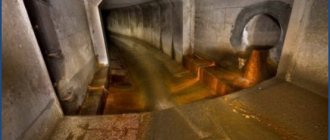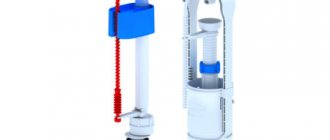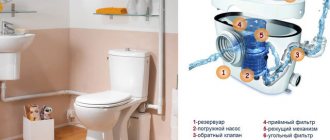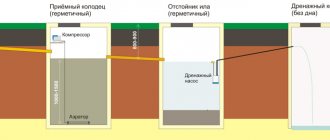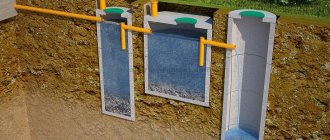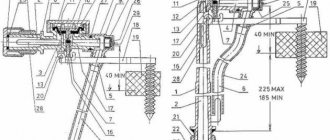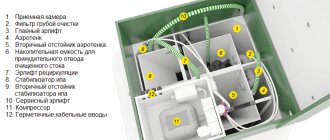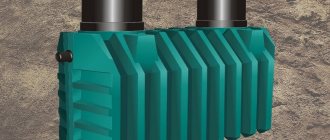In private and sometimes in communal residential buildings, when installing sewer lines with your own hands, you have to independently take measures to combat unpleasant odors from the pipes. One of the effective solutions to get rid of odors, which is widely used by plumbers, is to use a sewer aerator.
The device is sold in the retail chain in various versions; for its proper installation, it is useful to know the principle of its operation, the range offered, and installation diagrams. If you provide for the placement of an aerator at the design stage of a house's sewer system, you can significantly change the project, make it cheaper, and make the design of the premises more aesthetically pleasing.
Aerators in the sewer system
Why do you need a pipe aerator?
Any sanitary fixture is equipped with a water seal - a siphon, in the bend of which there is always water, which acts as a plug for the gases in the pipe. But this plug can “break” if a volley of wastewater is discharged into the sewer, for example, when draining water from a bathtub or a full kitchen sink. The failure occurs due to a vacuum forming in the cavity of the pipe when all the air is drawn with water. It literally sucks the plug out of the siphon, opening the way for gases to enter the room.
A sewer aerator prevents this process; it lets atmospheric air into the system, thereby equalizing the pressure in it. Essentially, it ventilates the internal cavity of the pipes, filling them with fresh air.
Previously, for this purpose, a ventilation (fan) pipe was installed everywhere, mounting it on the main riser and leading it vertically out through the roof.
Ventilation riser exit through the roof Source strojdvor.ru
For owners of private houses, this is not the most convenient solution, since installing a riser increases the cost of the sewer system, violates the integrity of the roof and does not add aesthetics to the rooms through which it passes. All this can be avoided by installing a 110 sewer aerator at the outlet from the riser directly in the house or in the attic.
See also: Catalog of companies that specialize in water supply, sewerage and related work
Sewer aerator: operating principle
During a volley discharge, when a lot of liquid is drained at once, the pressure in the sewer increases significantly. When the liquid leaves the local branch and approaches the central riser, the vacuum in the pipeline leads to the failure of the water seals, as a result of which an unpleasant sewer smell enters the apartment.
To avoid such a nuisance, a ventilation pipe leading to the roof is mounted on the riser.
However, this method has significant disadvantages:
- the ventilation pipe may become clogged;
- there is a possibility that the integrity of the roofing surface will be damaged during installation;
- In old buildings, it is often not possible to use such ventilation.
Therefore, a sewer aerator is most often used. Simultaneously with the decrease in pressure, the membrane is affected, as a result of which the channel opens.
Air passes through it, allowing pressure levels to stabilize. After the water leaves and the pressure stabilizes, the valve closes on its own, which prevents odors from entering the house.
Types and design of aerators
The range of sewer aerators in specialized stores is impressive: plastic and steel, with different shut-off valve designs and installation diameters, domestic and imported. But there is no point in understanding this diversity if we are talking about a household gravity drainage system for draining wastewater from a private house. The simplest and cheapest plastic aerator valve with a diameter of 50 or 110 mm is used here.
The most popular types of household aerators Source electro102.ru
The device consists of a housing with a cover, under which a valve with a rubber gasket is installed. In its original position, it blocks the ventilation hole in the housing. When the pressure in the system decreases, the valve automatically rises, opening the channel and letting air into the pipe. As soon as the pressure stabilizes, the valve lowers into the channel under its own weight and closes it, preventing the unpleasant odor from leaking out.
How to choose based on the characteristics and cost of the device
If you decide to purchase a sewer aerator, you should know how to choose the right device model. First of all, before purchasing, it is advisable to know the main points about your own sewage system and the desired type of fixture:
- horizontal, vertical or mixed pipeline;
- nominal pressure level;
- fixture size and chosen installation method;
- what material is the aerator made of and its strength;
- type of valve: vacuum, membrane, combined, cylindrical, lever;
- the ability to independently regulate equipment if a defect occurs. This is necessary in order to avoid the failure of the hydraulic seals if the valve gets stuck in the closed state;
- ball or rotary mechanism of the aerator;
- the presence in the design of a unit that prevents rats from entering the house from the sewer system.
In most cases, the choice should be based on pipe diameters, drain orientation, and the required tasks the fixture must perform. The cost of an aerator device, as a rule, is not too high, and the equipment does not require expensive and time-consuming installation, so if in doubt, it is recommended to install an aerator to improve the quality of the sewer system.
Reasons for installation
The condition of the sewer system is constantly changing. Due to the decomposition of sewage and household waste, gases are formed that affect the functioning of the pipeline. Draining through plumbing leads to a change in hydraulic conditions.
In the absence of tools for adjusting the operation of the sewer system, it will quickly become clogged and begin to work poorly. This will bring many unpleasant moments to the owner of a house or apartment.
That is why it is recommended to take care in advance of the proper functioning of sewer pipes and to prevent the occurrence of unpleasant odors. The easiest way to do this is with a sewer aerator.
The main advantages of its installation:
- protects the ventilation pipe from freezing in winter and autumn;
- operation does not depend on the availability of electricity;
- low cost of most models, usually 100-200 rubles;
- simple installation process, does not require complex installation, so the procedure can be easily carried out by a person without relevant experience;
- sewer pressure adjustment is carried out automatically.
The sewer aeration valve 110 equalizes the difference between the internal hydraulic regime of the pipeline and the external one, but can operate at a height of no more than 2 floors. Such a valve may not be able to cope with the load if drainage from 2 or more plumbing fixtures occurs simultaneously.
In this case, it is better to install an aerator with a diameter of 50 mm on a local branch of the internal sewerage system. In most cases, such devices are installed where the pipe diameter is reduced from 50 to 32 mm. The device is installed in horizontal areas and equalizes the pressure, simultaneously displacing the unpleasant sewer odor.
How to install a sewer aerator
After becoming familiar with the operating principle of the device, you can begin the process of installing the device. Installation is not a complicated procedure, but it is important to follow all the steps exactly and follow the rules. Before starting installation work, you should turn off the water supply to the riser and warn your neighbors if the installation is being carried out in a high-rise apartment building.
A small section of the pipe is cut off and the aerator is installed according to the instructions. If the pipe is located horizontally, then the arrow shown on the equipment must coincide with the direction of the sewer drain.
With the rapid movement of sewer liquids, the pressure changes, as a result of which the valve is activated and the air channel opens, through which the air pump occurs. When the pressure drops, the spring closes the valve, which prevents the smell from entering the room.
Watch the video
Installation sequence:
- The area where the device will be located is cut off from a horizontally oriented pipe. If the aeration valve will be placed on a vertical riser, then it is mounted at the highest point.
- The pipe is prepared: it is cut to the required size, and nicks are removed from the cut. If you are installing an air valve for the ventilation pipe, this step can be skipped, because it is installed on the end of the pipe.
- To seal the connections, a rubber gasket is used, installed in the socket. If installation is carried out using a thread, FUM tape is used instead of a gasket.
- The aerator is placed and secured directly.
There are certain installation features for each model, depending on the manufacturer. To find them out, it is recommended to carefully study the instructions that come with the equipment. After installation, it is advisable to carry out preventative cleaning of the valve every year. Membrane models should be cleaned more often.
Selection and installation
When choosing an aerator, the main criterion should be its throughput. The more plumbing fixtures in a home that can be used at the same time, the greater the volume of air that must enter the pipes through the aeration valve. Especially if the house is two or three stories high. In such cases, it is necessary to install a device with a cross-section of 110 mm on a riser. For apartments and one-story houses with one riser, a 50 mm valve is sufficient.
It is also worth paying attention to the quality of the product and checking its operation by removing the cover from the aerator. Due to the loose fit of the gasket to the valve head, it can allow an unpleasant odor from the pipes to enter the room.
Aerator sizes: 110 or 50 mm
Modifications of sewer aerators may differ both externally and in internal structure, but they are all united by the principle of operation. Aerators are available in different sizes. The most popular sewer aerators are of the following sizes:
- a modification measuring 110 mm is installed on a common sewer pipe, which has access to the attic. In the bathroom of a private house or apartment, the aerator can be mounted on an auxiliary riser, and one of the aerators must be placed in the attic;
Connecting the air valve to the sewer
- A 50 mm aerator is installed near plumbing fixtures. One aerator of this format is designed to serve one, maximum two plumbing fixtures. Such an aerator is required for installation if the length of the horizontal pipe is sufficiently long or if there is a transition of pipes of different diameters. For the device to work correctly, the pipes must have a horizontal slope.
Advice. In order not to subject the aerator installed on the drain pipe of a washing machine or dishwasher to excessive load, it is worth installing it at the top of the sewer riser.
Briefly about the main thing
The appearance of an unpleasant odor from the shower stall or kitchen sink cannot please the residents of the house. This problem often arises when there is no drain pipe or it is clogged, and it is not at all difficult to solve if you know what an aerator is in the sewer and why it is needed. This small device has a very simple design, it is easy to install it yourself without redoing the entire pipe system. Its main task is to let air into them to equalize pressure after a massive discharge of wastewater, leading to the destruction of water seals.
Ratings 0
What is it for?
An aerator is a ventilation valve that is a substitute for a drain pipe. It represents the exit of the riser to the outside, through the attic floor and the roof of the house. The upper end of the sewer pipe is open, providing ventilation to the internal volume of the sewer network. In some multi-storey buildings, the riser does not have an exit to the outside, which creates conditions for sudden changes in pressure. During a volley discharge of water, a vacuum occurs in the upper sections of the riser, which can rupture the water seals of bathtubs, toilets and other devices. The sewer aerator plays the role of an inlet valve, which equalizes the pressure and maintains the tightness of the system. There are universal devices designed to correct pressure in both directions - both low and high. They are used to compensate for high pressure in the riser of a multi-story building. Even with a waste pipe, the volley discharge of wastewater creates excess pressure in the pipes. It finds its way into apartments through broken water seals. Such structures are installed in the attic or basement, since it is impractical to release aeration gases into the living space.
Features of operation
An aerator installed according to the rules and in accordance with the developed scheme works without failures. This is evidenced by the absence of third-party odors in the apartment/house. However, it happens that externally the device performs its functions, but odors penetrate into the room. More often, such changes occur when additional household appliances are installed, which release water under high pressure into the collector. The previously installed valve simply does not have time to cope with the new task. In this case, it is better to additionally install another aerator.
Otherwise, the device does not require complex maintenance for the entire period of operation.
General rules for installing a vent valve
Before installation, you must first check the valve for leaks. The easiest way to do this is to fill it with water from the side from which air should not flow into the housing and check this part for leaks.
The aerator is installed exclusively in a vertical position. When placed horizontally or installed at an angle, the manufacturer does not guarantee its correct operation. To achieve the desired location when installing the valve, you can use tees and elbows that will help install it vertically.
Although the device does not require regular technical inspection, it is still necessary to provide access to it for cleaning if necessary.
To correctly place the valve, choose a vertically directed pipe, or install it on a horizontal section using various adapters. There are also models with connections designed for installation on horizontal sections of the pipeline
During installation, it is necessary to ensure free flow of air to the aerator, since water when drained can carry with it air, the volume of which is 25 times greater than the amount of waste liquid itself.
It is especially important to take this feature into account when installing a hidden aerator for a sewer system.
Connect the vent valve by removing it from the drain point horizontally or diverting it upward above the riser. For different connection options, tees, turns, adapters, and reducing inserts are used
It is installed above the connection level of the outermost drain point (in the place furthest from the riser). To exclude the possibility of splashes and dirt getting on the sealing membrane - the main working element - the aerator is installed above 300 mm from the junction with the riser.
When installing an aeration valve, certain rules are followed. It can completely replace the fan riser only in case of low water consumption
The device is mounted in places accessible to air intake. This could be an attic, a technical floor or a bathroom on the top floor of the house. All rooms must be ventilated or equipped with hoods.
The operating temperature range of different device models can vary from –50 °C to +95 °C. When installing an aerator in an unheated part of the house, the sewer riser (pipe) is insulated. The valve body does not need to be protected from negative temperatures, since there is an air cavity between its cover and the body, which can serve as insulation.
Conclusions and useful video on the topic
Operating principle and purpose of the fan valve:
Installing a drain valve can certainly significantly improve the operation of the sewer network. But its installation should not be considered as a panacea for all possible troubles associated with poor performance of the drainage system.
If you have installed an air valve in a sewer system yourself or have the necessary knowledge and skills, please share them with our readers. Leave your suggestions and ask questions in the block below.
Cost calculation
A caring homeowner must take care of his house/apartment, for which various companies offer valves at a price in the range of 500-5000 rubles, which often includes work.
Typically, the work lasts about 2-3 hours and with the services of professionals costs between 5-10 thousand rubles. Much also depends on the complexity of the work being carried out.
Sometimes it is necessary to dismantle the sewer pipe in the entire section and install a new one, and only after that it becomes possible to install an aerator.
If you do not know and do not understand what kind of aerator is required and whether it is needed in principle, you can seek advice from a plumber, but it is still necessary to note that this device, although not always necessary, has significant advantages without bearing negative effect, therefore, if you can afford it, it is worth improving the sewage system in your home with the help of an aerator. And this article will tell you in detail what a septic tank is and how to pump out a sewer in a private house.
Installation instructions
Almost all vacuum aerators are manufactured for the common pipe connection DN110 with a diameter of 110 mm. If the diameter does not fit the connection, a profile adapter is used. There are also pipes DN50 and DN75, with a diameter corresponding to the digital designation, for which valves with an outlet of 50 and 75 mm are used.
It is important to understand that a 110 mm sewer air valve used for pipes with a diameter smaller than this size is installed at a maximum of two points in the main line. To install the valve in a metal pipe, special adapters are also used, which guarantee a tight joint between the plastic and the metal.
Before installing a vacuum aerator, it is necessary to decide on the installation location, taking into account the location rules and accessibility for future maintenance. After this, turn off the water in the room by closing the taps on the pipes. If installation is required in an already completed pipeline, the valve is inserted and the appropriate adapter is installed.
Vacuum fittings
There are many products related to vacuum fittings. Each device has its own scope and features. The vacuum seal is used not only for sewage. For example, an electric vacuum valve is used in a wide variety of equipment. It is capable of providing air supply and exhaust.
The throttle solenoid valve is used to maintain vacuum in general purpose systems. Vacuum devices are widely used in mechanical engineering. For example, a car brake booster, automatic transmission, fuel pump and a host of other devices.
Without all of the above, the car engine will not be able to perform its functions. Of course, the listed equipment has nothing to do with the arrangement of sewer lines, but it proves the practicality and reliability of all vacuum fittings.
Watch the video:
